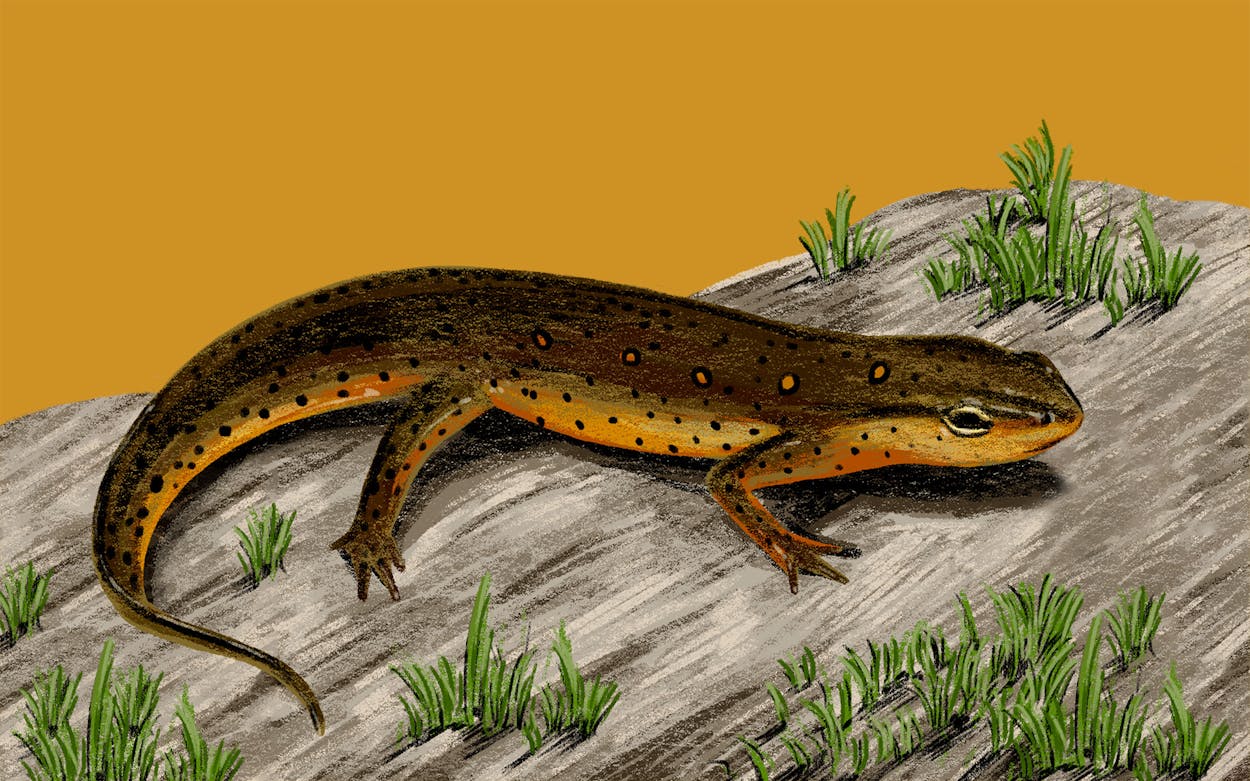Latin Name: Notophthalmus viridescens
Size: About three to five inches long (adult)
Habitat: Ponds and damp forest floors in East Texas
“Eye of newt and toe of frog,” chant three witches in Shakespeare’s Macbeth as they tend to a foul, bubbling cauldron. In the Harry Potter books, NEWTs (Nastily Exhausting Wizarding Tests) are the equivalent of the dreaded SATs. And the titular heroine of Roald Dahl’s Matilda uses her magical powers to scare an evil headmistress with a newt. These stealthy amphibians conjure visions of sorcery for good reason: most of them are toxic. “Newts are absolutely something that could poison you,” says Matthew Kwiatkowski, a herpetologist at Stephen F. Austin State University, in Nacogdoches. So let’s get to know the eastern newt!
What’s a newt, anyway?
It’s a type of salamander, typically small and rough skinned. Newts are much more common in Europe and Asia than in the U.S., which might help explain their medieval vibe. More than a hundred species are found globally, but the only ones wriggling around our fair state are the black-spotted newt, in South Texas, and the eastern newt, in swampy East Texas, including Nacogdoches. Both secrete a neurotoxin from their skin as a defense against predators. The eastern newt is common across the Eastern U.S., with Texas defining the western end of its range. Some folks also call it the red-spotted newt, for its vermilion dots that warn: “Stay away, I’m poisonous!” (Only if you eat it.)
Darn, I was looking up newt recipes. What else should we know?
“They have a really complex life cycle,” says Daniel Saenz, a wildlife biologist with the U.S. Forest Service in Nacogdoches. The eastern newt can go through as many as four stages: egg, aquatic larva, terrestrial eft (or juvenile), and aquatic adult. Newts have an amazing ability to live fully on land or fully in water. The East Texas population seems to skip the aquatic adult stage except for a brief period in the winter, when they breed primarily in ephemeral ponds. If the pond dries up, no worries: the li’l guys just go terrestrial. This may help explain their impressive lifespan, which can reach fifteen years.
What does a newt eat?
Any animal smaller than it, such as termites, springtails, and other tiny bugs. “They’re kind of a weird deal,” says Saenz. “These little, soft gummy bears are actually ferocious predators.”
Do they have any odd mating habits?
So many. Eastern newts engage in ritualistic underwater courtship, with the male waggling his tail flirtatiously to attract a mate. He also emits enticing pheromones and grasps her with his hind legs. The act itself is very formal: he deposits a sperm packet in the water, and she later picks it up with her cloaca and fertilizes it. Instead of laying a clump or string of eggs, as you might expect, eastern newts scatter their offspring around the pond. “She puts them under leaves and spreads them all out,” Saenz says. “It’s a successful strategy.” From the moment they’re laid, the eggs are on their own, and most won’t survive. That’s why she lays at least two hundred at a time. Swim fast, little newts!
An abbreviated version of this article originally appeared in the December 2023 issue of Texas Monthly with the headline “Eastern Newt.” Subscribe today.
- More About:
- Critters
- Nacogdoches









